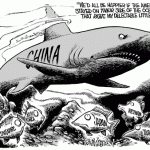
Major tendencies in the 21st century such as intensifying levels of globalisation, increasing levels of multiculturalism in workplaces, increasing threats of international terrorism, rapid innovations in information technology and others have direct and indirect implications on various processes in society, and their analysis from sociological viewpoint is necessary in order to assess these implications in a holistic manner. Changes in the nature of work include increasing level of informality of organisational culture, increasing popularity of alternative working patterns and decline of popularity of lifelong employment for a single organisation have great potential to contribute to human well-being in various levels. Theoretical perspectives to sociology can be divided into three categories: functionalism, conflict and interactionist. Benefits of changing nature of work to human well-being can be effectively explained through the lenses of each of these perspectives. Changing nature of work related to increasing popularity of alternative working patterns such as part-time, flexitime, telecommuting, job sharing and compressed workweek have a great potential to improve the levels of work-life balance for many people. Sociology studies rationale behind human behaviour, and from this perspective rationale behind increasing numbers of people preferring engagement in alternative working patterns can be explained as the willingness to improve the levels of their work-life balance. Businesses can reduce the levels of operational costs by adopting alternative working patterns and this relates to conflict perspective in sociology to a certain extent. In other words, the conflict perspective to sociology and related theories which are mainly derived from teachings of Karl Marx focus on competition between various groups for resources, as well as, power and influence. According to this approach, cost reduction by businesses achieved by adoption of alternative working patterns can be used as a source of competitive advantage to compete with other businesses in the global marketplace. Decline…
By John Dudovskiy
Category: HRM

In simple terms, sociology can be defined as interaction between individuals and groups. Sociology is a broad area and encompasses a wide range of topics and issues such as culture, interactions between people, levels of inequality in a society, socialisation etc. and impact of all of these on human behaviour and thinking. This essay focuses on a narrow segment of sociology, which is explanation of changing nature of work through sociology. The approach to sociology can be divided into two groups: micro and macro. Micro-sociology focuses on study of behaviour in various situations in a daily life. Macro-sociology, on the other hand, has a broader scope and employed to explain the various aspects of broad social systems. Changing nature of work can be explained from both perspectives – micro-sociology and macro-sociology. From micro-sociology perspective, changes in the nature of work as described above have certain implications for employees in individual and personal levels such as possibility to achieve greater levels of work-life balance in multiple ways. Alternatively, from macro-sociology perspective, national and global implications of changes in the nature of work are assessed such as resulting changes in cultural values, competitive advantage to be gained by local producers due to cost reductions, and others. Relatively recently the notion of meso-sociology has also been introduced and this refers to “analysis of social phenomena in between the micro and macro levels” (Doda, 2005, p.17). Moreover, embracing of alternative working patterns is becoming a popular pattern of social behaviour. Distinctive features of this behaviour include extensive use of internet for a wide range of purposes and social mobility. Popular theoretical approaches to sociology include Functionalism, Marxism, Feminism, Post-Modernism, Theory of Rational Choice and others and each of these approaches is a broad topic on their own accounts. Nevertheless, assessment of implications of changing…
By John Dudovskiy
Category: HRM

The last several decades have witnessed gradual and dramatic changes in the nature of work due to a number of reasons that include, but not limited to intensifying level of competition in marketplace, developments in information technology and other technological developments, increasing forces of globalisation and certain aspects of demographic changes. Increasing popularity of alternative working patterns such as part-time working, flexitime employment, telecommuting, job-sharing and compressed workweek marks the most important change in the nature of work in the 21st century. It has been estimated that “currently around 29 per cent of UK employees work part-time or in some other form of flexible working pattern” (Holbeche, 2013, p.58). Part-time working is not a new practice in modern times; however, the popularity of part-time employment has increased during the last couple of decades due to attempts to improve the levels of work-life balance and a set of other reasons discussed below in a greater details. Flexitime employment as a different version of alternative working patterns “specifies core hours when people must be on the job, with flexible starting and finishing times as long as required total hours are worked” (Swanepoel et al, 2008., p. 217 as taken from Bartol et al., 2008, p.413) Telecommuting, on the other hand, can be explained as “to work at home using a computer connected to the network of one’s employer” (Free Dictionary, online, 2014) and it offers the advantages of working from the comfort of home. Job sharing involves roles and responsibilities of a single position being assumed by two or more employees so that each employee has extra free time to devote to pushing hobbies, spending time with the family and other activities of their choice. Compressed workweek working pattern permits employees to complete required hours for the week in less than traditional…

With the increasing forces of globalisation the need for trade regulation in an unbiased and objective manner increases. This role has been assumed by World Trade Organisation (WTO) and its functions include administration of trade agreements, serving as a forum for trade negotiations, dealing with trade disputes between its members, and monitoring policies of its members related to trade. Established in January 1, 1995, WTO comprises 159 members and it is based in Geneva, Switzerland (Annual Report, 2013). There are contradicting assessments of WTO performance in terms of regulating trade between counties in an effective manner. You can read more scope, contribution and criticism related to WTO here. On one hand, WTO has been praised for such positive impacts as stimulating economic growth and increasing the level of employment, encouraging good governance practices, contributing to peace and stability and settling trade disputes amongst its members (Ahern and Fergusson, 2010). On the other hand, WTO critics argue that the organisation has made a counter-productive impact on development of a range of its members, and it also has been blamed for neglecting environmental issues. Moreover, WTO has been criticised on the grounds of political bias for serving as an instrument at the hands of its few hegemonic members. Moreover, there are other international organisations which are parts of United Nations Organisations (UN) such as World Bank, and International Monetary Fund (IMF), that have certain impacts in international trade practices. UN in general, and its Economic and Social Council in particular can be specified as another international organisation that does have impact on trade regulation between countries. Comprising 54 members for three-year terms, the Economic and Social Council aims to promote international cooperation in order to achieve economic and social development. Millennium Development Goals is one of the most noteworthy economic initiatives proposed…

In line with the advantages of free trade discussed here, there is a set of objections to free and these objections can be represented through the following four points. Firstly, free trade is criticised due to its perceived disadvantages to local producers. The concept of free trade promotes open competition without barriers in the global scale. Thus, companies from abroad with strong competitive edge may present serious threat to the levels of revenues of local businesses. However, this threat can be used as a positive factor as well, in terms of motivating local producers to innovate and search for additional sources of competitive edge in creative ways. From this perspective, local producers need to be assisted by government through building effective infrastructure for competition rather than being protected from foreign competitors limiting their motivation to innovate. Secondly, free trade is blamed for causing trade deficits with detrimental impacts on national economy. Specifically, trade deficit is an absence of balance between imports and exports and reducing the levels of trade deficits is one the main macroeconomic goals of the government. Trade deficit between US and China has been estimated to be as much as USD 40.6 billion (Crutsinger, 2014, online), and a range of economists point to this number as one of the main reasons for severe economic issues in the US. At the same time, counter-argument can be formulated in a way that “a growing trade deficit, despite its misleading name, is a good for the economy. It is typically a signal that global investors are confident in America’s future” (Boudreaux, 2014, online). In other words, there is a positive correlation between trade deficit and the levels of investment in the national economy from abroad, and these investments have great potential to revive national economy. Thirdly, free trade is criticised for…

Free trade can be defined as “a policy by which a government does not discriminate against imports or interfere with exports by applying tariffs (to imports) or subsidies (to exports)” (Britannica, 2014, online). In simple terms, free trade can be explained as an absence of government intervention to the practices of selling to and buying from another country. Promoted by famous economist Adam Smith and David Ricardo, perceived advantages of free trade include benefits to be gained from specialisation practices engaged by countries according to their competitive advantages. This benefit based on theoretical frameworks of absolute advantage and comparative advantage. Specifically, according to the theory of absolute advantage proposed by Smith (1976), countries are perceived to have absolute advantage in producing a product if the production is facilitated in the most efficient way than other countries. Comparative advantage proposed by Ricardo (1817), on the other hand, refers to “the ability to produce a specific product more efficiently than any other product” (Pride et al., 2011, p.70). According to theories of absolute advantage and comparative advantage focus on manufacturing products that can be produced more efficiently than other countries and trading these products for other products with different countries generates more economic gain and value compared to attempts to diversify production within a single country. A basic classical example of trade of two products between two countries found in the most economics textbooks illustrate the advantage of free trade in the most effective manner. Moreover, free trade encourages competition in the market, motivating local producers to find and utilise sources for competitive edge on a constant basis, and high level of competition in the market offers benefits to consumers in terms of more variety of products and services, higher quality, and competitive prices. Another advantage of free trade can be specified…

Explanation of the outbreak of the Great Recession of 2007-8 in a chronological order is necessary in order to provide detailed information about the case study, and link discussions and analysis in following chapters to specific events within the chronology. Date Event 2007 AugustOctober December Funds freezed by the US Federal ReserveRecord high at Dow Jones Official start of the recession in the US 2008 MarchJuly September October November Collapse of Bear SternsGDP fall of 0.6% confirmed Denmark as the first European economy to face recession Record unemployment rate in the US during the last 5 years Takeover of Fannie Mae and Freddie Mac US President George Bush signs USD 700 billion bailout fund Singapore is the first Asian country to face recession with the economy shrinking 6.3% Hong Kong confirmed as the 2nd Asian country to face recession 2009 JanuaryFebruary June GDP fall of 1.5% in 4thquarter of 2008, confirms the beginning of recession in the UKObama stimulus package signed Issue of Greece’s budget deficit emerge 2010 JanuaryApril October UK economy comes out of recession with a GDP growth of 0.1%Creation of 162,000 job in the UK Greece and Ireland are bailed out in the EU as a result of adoption of austerity measures 2011 April May Portugal asking for the EU help in dealing with its financesPlanning of a permanent rescue fund in EU by leaders of its members The loss of US AAA credit rating Approval of EURO 78 billion bailout for Portugal by EU leaders Chronology of the Great Recession of 2007-8 Source: Roberts (2009), Heng (2010) and Hetzel (2012) References Heng, M.S. (2010) The Great Recession: History, Ideology, Hubris and Nemesis, World Scientific Hetzel, R.L. (2012) The Great Recession: Market Failure or Policy Failure, Cambridge University Press Roberts ,M. (2009) The…

While there is a consensus amongst authors regarding rapid hegemonic rise of China opinions divide about sustainability of this tendency in long-term or even medium term perspectives. On one hand, there are authors such as Zhang (2012), Sobel (2012) and Joseph (2013) who express firm belief about the sustainability of Chinese hegemony. This group of authors refer to the strong competitive advantage of economy of China that is expanding beyond the cost advantage of resources to compete with producers from developed countries on quality levels. On the other hand, a range of authors such as Catley and Mosler (2007), Balogun (2011) and Nye (2011) adopt a sceptical approach about sustainability of hegemony of China in long-term perspectives. This specific group of authors justify their stand by stating that China’s hegemonic rise is directly conditioned by its volume of exports, and sustainability of volume of export depend on a wide range of internal and external factors that are becoming increasingly volatile. Nevertheless, the literature review has found a set of political, economical and social factors that contribute to the rise on the level of hegemony of China. Each of these factors is discussed below in greater details. Political Factors Political factors contributing to the rise of China’s hegemony are closely associated with damages to the reputation of present world hegemon – the USA through unsuccessful engagement in a series of foreign wars (Catley and Mosley, 2007, Zhang, 2012, Joseph, 2013) and a range other factors discussed below. Zhang (2012) argues that financing overseas wars in Iraq, Afghanistan, and Libya is draining national economy of the USA. Moreover, eagerness of the US President Barack Obama to initiate military engagements in Syria is most likely to have highly detrimental impacts on the level of national economy. Moreover, US government sponsors a range…

According to Nye (2011) wars and military conflicts between countries are never going to cease in the future because confrontionism is deeply rooted in human genes. Generally, the debate regarding hegemony can be divided into two broad and opposing categories. On one hand, supporters of Habermas such as Catley and Mosler (2007), Russett (2011) and Baker (2011) do believe that it is possible for countries to engage in international relations without dominant power in an effective manner. On the other hand, supporters of Foucault such as Schake (2009), Balogun (2011), and Nye (2011) argue that international relations cannot be facilitated without power, but the nature of power can be represented in various formats. In other words, according to this stance hegemonic power will always influence international relations; however, the level of evidence of this influence varies according to a range of factors. Lee (2010), Russett (2011) and Baker (2011) find positive correlation between rising military power of a state and its hegemonic ambitions. Table 2.1 illustrates major hegemonic wars during the last several centuries and contains information about their results. Hegemonic War Duration Results Thirty Years’ War 1618 – 1648 Defeat of Habsburg Wars of Louis XIV 1667 – 1713 Defeat of France Napoleonic Wars 1792 – 1814 Defeat of France; Emergence of Britain as hegemon World War I 1914 – 1918 Defeat of Germany World War II 1939 – 1945 Defeat of Germany; Emergence of the USA as hegemon Table 2 Hegemonic wars during last several centuries and their results Source: Lee (2010) US Hegemony in the 20th Century and Its Perception by other Countries According to Catley and Mosler (2007) the US hegemony has mainly started after the World War II of 1939 – 1945. Specifically, Catley and Mosler (2007) link this fact to the chosen stance of…

Initially introduced by Ogranski in 1968, and further developed by Ogranski and Kugler (1980), the framework of Ogranski and Kugler’s Power Transition is based on the assumption that international order is hierarchically structured. According to this framework there are countries that are satisfied with their position in a hierarchical structure of the world order, at the same time when certain countries are not satisfied. Accordingly, Ogranski and Kugler’s Power Transition theory states that counties that are not satisfied with their positions in hierarchical structure of international order may develop hegemonic ambitions and initiate international conflicts. Moreover, Ogranski and Kugler (1980) divide the process power transition into the following three stages: The stage of potential power. This stage is associated with gaining access to reserves and competitive advantages, and increase in the level of their utilisation to fuel economic growth in the country. Nowadays, countries such as Indinesia and Singapore can be specified to be in the stage of potential power. The transitional stage is marked with the utilisation of newly gained sources of competitive advantage in an active and extensive manner to become a hegemonic state. China and India can be specified to be on transitional stage to hegemony. Power maturity is the stage where hegemonic decline is highly probable due to a range of reasons that primarily relate to the loss of competitive advantage in the global marketplace. The USA and the UK can be mentioned to illustrate the instances of power maturity.
By John Dudovskiy
Category: Politics
